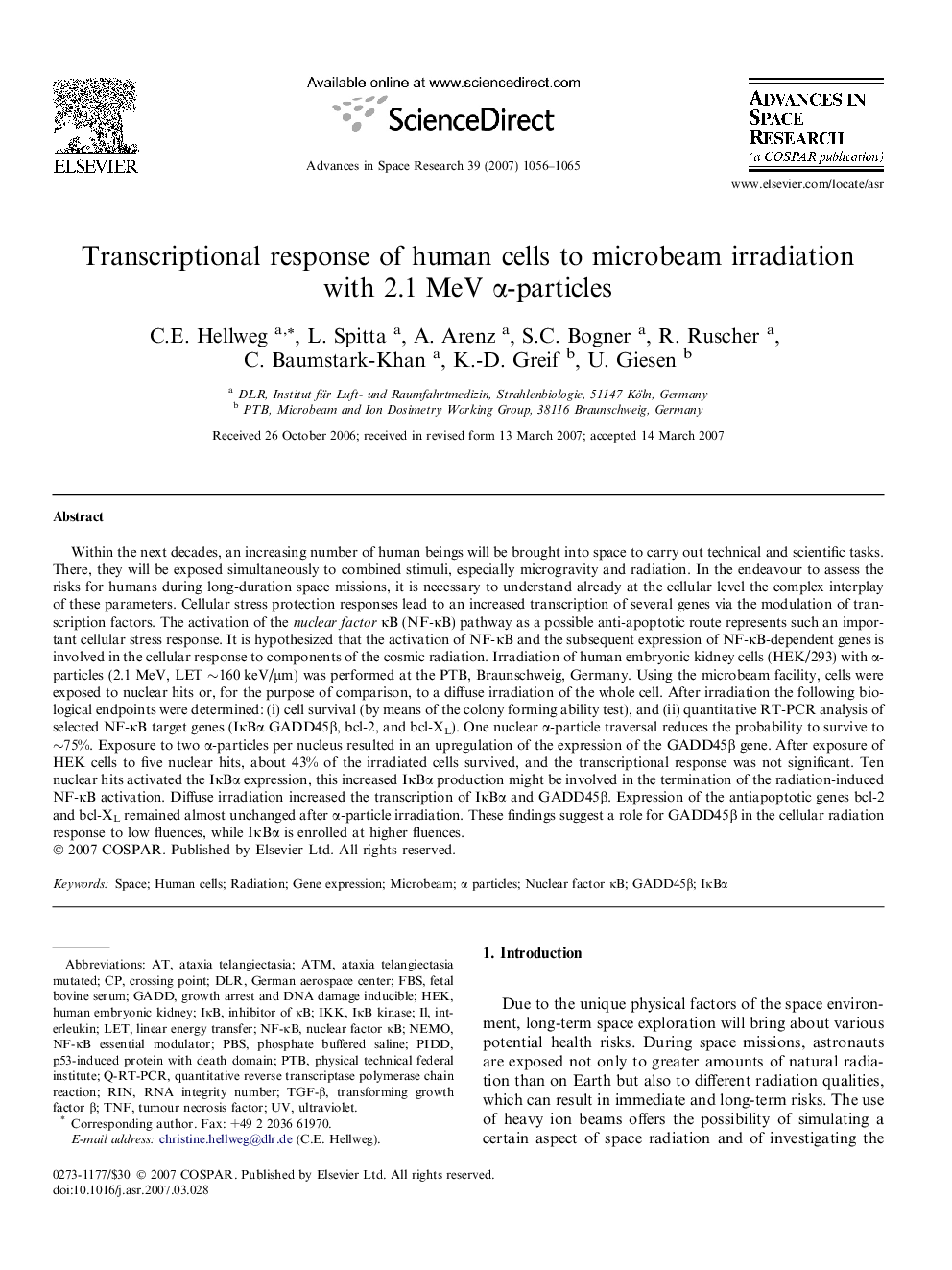| کد مقاله | کد نشریه | سال انتشار | مقاله انگلیسی | نسخه تمام متن |
|---|---|---|---|---|
| 1767599 | 1020197 | 2007 | 10 صفحه PDF | دانلود رایگان |
عنوان انگلیسی مقاله ISI
Transcriptional response of human cells to microbeam irradiation with 2.1 MeV α-particles
دانلود مقاله + سفارش ترجمه
دانلود مقاله ISI انگلیسی
رایگان برای ایرانیان
کلمات کلیدی
NF-κBTGF-βTNFGADDPIDDAtaxia telangiectasiaGadd45βPTBQ-RT-PCRIκBαIKKDLRIκBFBSNEMOPBSHEKataxia telangiectasia mutated - Ataxia telangiectasia جهش یافته استIκB kinase - IkB kinaseLET - اجازه دهیدUltraviolet - اشعه فرابنفشLinear Energy Transfer - انتقال انرژی خطیinterleukin - اینترلوکینGene expression - بیان ژنTransforming growth factor β - تبدیل فاکتور رشد βATM - خودپردازα particles - ذرات αRIN - رینfetal bovine serum - سرم جنین گاوHuman cells - سلول های انسانیRNA Integrity Number - شماره یکپارچه RNAtumour necrosis factor - عامل نکروز تومورnuclear factor κB - فاکتور هسته ای κBPhosphate buffered saline - فسفات بافر شورSpace - فضاNF-κB essential modulator - مدولاتور ضروری NF-κBGerman aerospace center - مرکز هوافضایی آلمانinhibitor of κB - مهار کننده κBMicrobeam - میکروبامcrossing point - نقطه عبورQuantitative reverse transcriptase polymerase chain reaction - واکنش زنجیره ای پلی مراز ترانس کریتاز معکوس کمیRadiation - پرتوhuman embryonic kidney - کلیه جنین انسان
موضوعات مرتبط
مهندسی و علوم پایه
علوم زمین و سیارات
علوم فضا و نجوم
پیش نمایش صفحه اول مقاله

چکیده انگلیسی
Within the next decades, an increasing number of human beings will be brought into space to carry out technical and scientific tasks. There, they will be exposed simultaneously to combined stimuli, especially microgravity and radiation. In the endeavour to assess the risks for humans during long-duration space missions, it is necessary to understand already at the cellular level the complex interplay of these parameters. Cellular stress protection responses lead to an increased transcription of several genes via the modulation of transcription factors. The activation of the nuclear factor κB (NF-κB) pathway as a possible anti-apoptotic route represents such an important cellular stress response. It is hypothesized that the activation of NF-κB and the subsequent expression of NF-κB-dependent genes is involved in the cellular response to components of the cosmic radiation. Irradiation of human embryonic kidney cells (HEK/293) with α-particles (2.1 MeV, LET â¼160 keV/μm) was performed at the PTB, Braunschweig, Germany. Using the microbeam facility, cells were exposed to nuclear hits or, for the purpose of comparison, to a diffuse irradiation of the whole cell. After irradiation the following biological endpoints were determined: (i) cell survival (by means of the colony forming ability test), and (ii) quantitative RT-PCR analysis of selected NF-κB target genes (IκBα GADD45β, bcl-2, and bcl-XL). One nuclear α-particle traversal reduces the probability to survive to â¼75%. Exposure to two α-particles per nucleus resulted in an upregulation of the expression of the GADD45β gene. After exposure of HEK cells to five nuclear hits, about 43% of the irradiated cells survived, and the transcriptional response was not significant. Ten nuclear hits activated the IκBα expression, this increased IκBα production might be involved in the termination of the radiation-induced NF-κB activation. Diffuse irradiation increased the transcription of IκBα and GADD45β. Expression of the antiapoptotic genes bcl-2 and bcl-XL remained almost unchanged after α-particle irradiation. These findings suggest a role for GADD45β in the cellular radiation response to low fluences, while IκBα is enrolled at higher fluences.
ناشر
Database: Elsevier - ScienceDirect (ساینس دایرکت)
Journal: Advances in Space Research - Volume 39, Issue 6, 2007, Pages 1056-1065
Journal: Advances in Space Research - Volume 39, Issue 6, 2007, Pages 1056-1065
نویسندگان
C.E. Hellweg, L. Spitta, A. Arenz, S.C. Bogner, R. Ruscher, C. Baumstark-Khan, K.-D. Greif, U. Giesen,